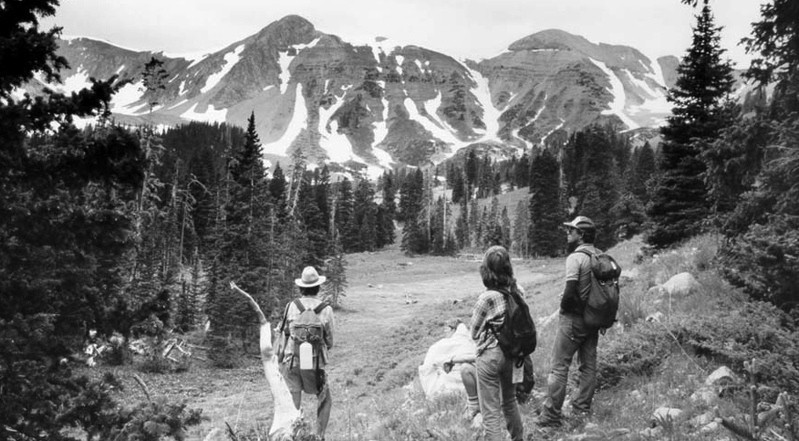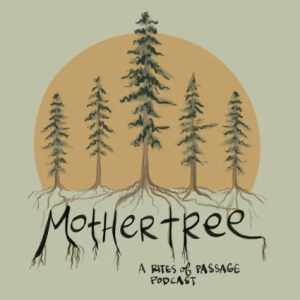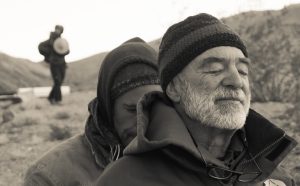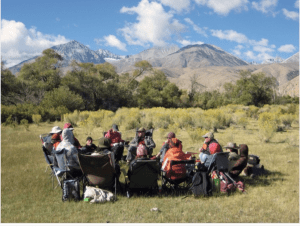
Wilderness Rites of Passage
From Taylor, Bron (Ed.). Encyclopedia of Religion and Nature. London: Thoemmes Continuum, 2005. Pp. 1748-1750.
For information on the Encyclopedia of Religion and Nature
Across time and in countless ways, people of many cultures have gone into the wilderness to mark life transitions and seek guidance. They sought closeness with God, the Mystery, or a higher self. They found a time alone, exposure to the elements in an unfamiliar place, a radical shift in self and world, a trial and a gift, and a ritual death and rebirth. The core of the form was clear: leaving the ordinary world, crossing a threshold, and returning with a gift and a task. It was an initiation, a rite of passage, a new birth in the womb of the natural world.
Modern cultures seem to have forgotten most of what our ancestors knew about the importance of initiatory rites for sustaining individuals and their communities. Instead, we find ourselves strangers in our own lives, unsure of our status and value, and hungry for a connection with the abiding rhythms of the Earth and an enduring spirit.
Yet, the roots of this search remain alive. Recently, a growing number of people have created wilderness-based rites of passage for a modern context. Steven Foster and Meredith Little, authors of The Book of the Vision Quest and The Four Shields of Human Nature, are among those most influential in developing and articulating a form appropriate to our time and place, the vision fast. Since the 1960s, they have trained vision fast guides through their School of Lost Borders and spearheaded the development of professional groups such as the Wilderness Guides Council. Recent developments in this field include greater collaboration among those doing such work in North America, Europe, Africa, and Australia and the development of programs and training in academic settings.
In general, people seek wilderness rites of passage in times of significant life transition or to complete life transitions begun earlier but not completed. The transition from adolescence to adulthood is an important time for initiation. Adolescents need the chance to confirm their fitness and willingness to step toward adulthood. Mid-life, marriage, divorce, loss, or simply a time of confusion and disillusionment are also common calls to a wilderness rite of passage.
These practices facilitate ego-transcendence and an opening to spirit. In doing so, they also bring healing and renewed connections with lost or abandoned capacities for guidance, vitality, and joy. Their goals include bringing back to one’s people and place something of value: personal power, stability, energy, wisdom, or a maturity that is expressed in service to others and to the Earth.
Structure of a Typical Wilderness Passage Rite
While there are many specific forms these quests can take, they all express a common deep structure. The anthropologist, van Gennep, used this deep structure to describe traditional rites of passage, and Carl Jung and Joseph Campbell use it as the basis for the archetype of the Hero’s Journey. Despite variations in surface structures, this pattern is broadly crosscultural. Here, I will describe a form currently being used by many wilderness rites of passage guides. It is built around a one- or two-week wilderness trip.
Preparation
This is a time for participants to identify their reasons, inner resources, and commitment for this undertaking. More mundane issues of logistics, equipment, and safety are equally important.
Severance
Participants travel to a wilderness setting and set up a base camp where they become accustomed to living close to the land, opening their senses to the features of that place, and tuning in to the rhythms of the Earth. Wilderness is a relative term, and many vision fast groups without ready access to wilderness have found that more cultivated lands can support this work. Processes for life review are helpful here. They use council-style group discussions and simple Earth-centered ceremonies along with walks, journaling, and contemplative practices such as meditation and sensory awareness.
Threshold
This phase usually comprises three or four days of solitude and fasting from food (with water, a buddy system, and other safeguards). Participants may engage in awareness practices and self-generated ceremonies, but aside from safety considerations, there are few rules. The threshold is the doorway into sacred time and space and the edge between the old, which is no longer, and the new, which is not yet. In many ways, the threshold time represents a symbolic death and facilitates an ego-death.The wilderness (or wilder) setting is an important part of the threshold phase, providing both challenge and support for the inner work of disidentifying from old psychic structures, creating deeper integration both within one’s psyche and with the world, and discovering deeper sources of relating to the world.
Return
The return, or reincorporation, phase is a symbolic rebirth. This begins upon the return to base camp with quiet celebration and reflection and continues as we rejoin our communities. Sharing stories and reflecting on them, participants begin to integrate their insights and visions. The goal is to help participants discover their own meaning in their experiences and apply their own belief systems, not to impose meaning.
Implementation
After the wilderness trip, participants are supported in bringing their experiences into their lives more fully. However, it is necessary that the work of this phase belongs to each participant. This is the phase in which the gifts of the initiation are shared. Essentially it is the rest on one’s life.
Elements of Wilderness Passage Rites
Key elements of these trips are the stages of the rites of passage model, a ritual or ceremonial attitude, and the wilderness environment. Underlying them is exposure. Participants are exposed to new terrain, weather, and wildlife, large and small. They are exposed to their own vulnerability, boredom, frustration, strength, contentment, delight, and curiosity – all the states that can emerge from being alone in a living place with an authentic intention of openness. The patterns and meanings of personal history, self-concepts, ideals, and shadows are exposed as well.
Changes in sensory and cognitive input from living closer to nature lead to changes in ego structures. Familiar ego structures are no longer supported, leading to changes in self-images and less fixated conceptual structures. The natural world mirrors, evokes, and develops those inner qualities usually assigned to the realm of religion and spirituality – unconditional love, joy, power, peace, support, grace, and guidance.Making intimate contact with the wild world brings us into contact with our “wild selves,” the parts of us that have not been conditioned by familial and cultural forces. Wild places are those not under our control and not subject to our wills, walls, or arbitrary boundaries. On wilderness rites of passage, as in all forms of deep psychological or spiritual work, we are going into wild places. We are entering realms where the artificial structures and demands of the ego and society have not restricted or walled off our innate guidance, aliveness, generosity, or fascination with the world. At the same time, wilderness rites of passage cultivate and refine those qualities necessary for living in the world in a full and engaged way, knowing our own hearts and minds, tolerating ambiguity and discomfort, being autonomous, searching deeply, and staying open to new answers.
Sometimes, the “visions” of a vision fast resemble shamanic experiences with unusual sensory or psychospiritual manifestations. More often, however, the most transforming and longest lasting changes are prompted by subtle, more ordinary experiences. It is the totality of the rite rather than a specific experience that usually carries the deepest impact.
In most modern wilderness rites of passage trips, participants discover a renewed relationship with the natural world, a sacred relationship. To the detriment of this relationship, participants can idealize and romanticize wild nature and the ceremony, causing a split between the wild and their familiar worlds. Such a split tends to foster dissatisfaction and depression as well as rejection of the needs of one’s home community and its natural setting. One of the goals of wilderness rites of passage is to support participants in returning home with a new or renewed commitment to living in a more sustainable way and caring for the earth as well as a new sense of self.Such responsible environmental action arises not from a sense of imposed obligation or coercion, but from the deep psycho-emotional bond arising from spending such ceremonial time alone in nature. Environmental action, whatever form it takes, becomes an expression of love, joy, and caring rather than a product of shame, guilt, or fear. The world becomes less a collection of commodities to be used or exploited, and more the embodiments of an alive, enchanted, sacred world. Many of these trips conclude with specific practices, often ritualized to deepen their meaning, which support participants in articulating and accepting a sacred task related to environmental responsibility. A lesson of modern wilderness rites of passage is that living authentically means living here and how, in this place, embodied, and part of the environment. Sacred (“heaven”) and profane (“Earth”) are not divorced.
This is not easy work, nor does it promise a quick fix. However, wilderness rites of passage and Earth-centered initiatory practices do develop confidence, trust, wholeness, a sense of enchantment and home in the wilder parts of our selves, and a natural impulse to contribute to our world. These are the foundations for maturity, inner freedom, and service.
Further Reading
Foster, Stephen and Meredith Little. The Four Shields: The Initiatory Seasons of Human Nature. Big Pine, CA: Lost Borders Press, 1998.
Foster, Steven and Meredith Little. The Roaring of the Sacred River: The Wilderness Quest for Vision and Self-Healing. Big Pine, CA: Lost Borders Press, 1989.
Foster, Steven and Meredith Little. The Book of the Vision Quest: Personal Transformation in the Wilderness. New York: Prentice Hall Press, 1988.
Greenway, Robert. “The Wilderness Effect and Ecopsychology.” In Theodore Roszak, Mary Gomes, and Allen Kanner. Ecopsychology: Restoring the Earth, Healing the Mind. San Francisco: Sierra Club Books, 1995.
Mahdi, Louise, Nancy Christopher, and Michael Meade. (1996). Crossroads: The Quest for Contemporary Rites of Passage. Chicago: Open Court Publishing Company, 1996.
See also: Breathwork; Ecopsychology; ECOtherapy; Naropa University; Native American Spirituality; Re-Earthing; Transpersonal Psychology; Wilderness Religion.
Share This
Related posts




